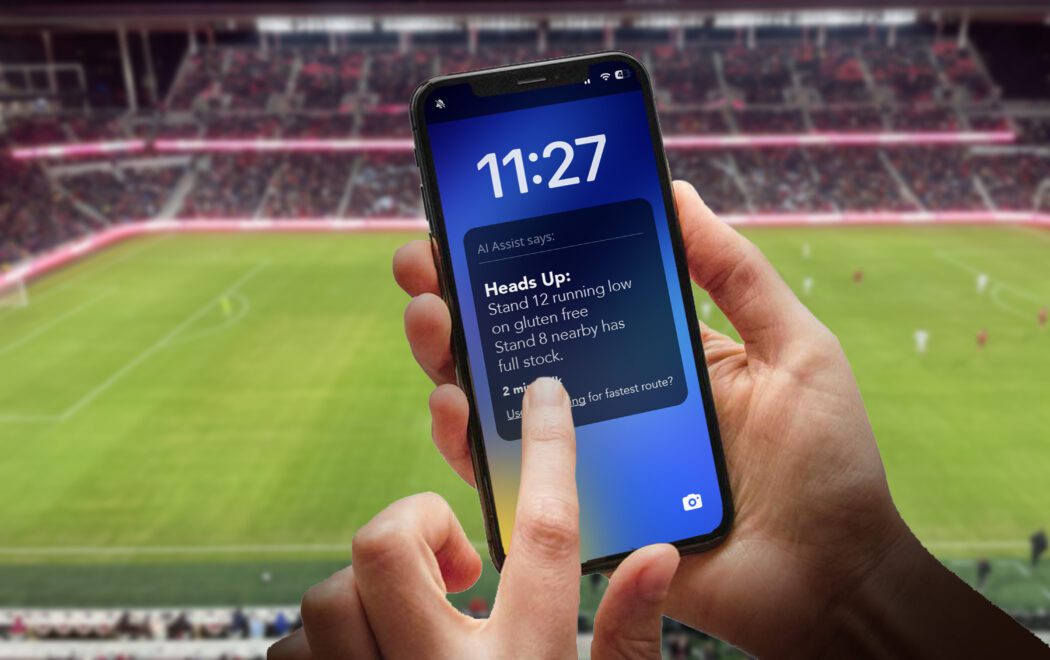
Stadium technologists are expected to be all things to all people, all the time. The result is predictable: swollen stacks of proprietary apps and vendor lock-ins held together by the few people who “understand IT.” If we bring the same habits into the age of AI, we’ll recreate the same mess, only in natural language instead of code.
AI’s real promise in venues isn’t as a god-system that micromanages every journey. It’s the opposite. The future belongs to edge intelligence: AI as a trusted orchestrator in the fan’s pocket that reads signals, executes microtransactions, and makes local decisions aligned to both the fan and the venue.
Twenty- thousand personalized orchestrators will always beat one centralized rules engine. Our job is not to script journeys; it’s to publish signals and define constraints so those journeys can emerge; safer, faster, and more personally than anything a control room can pre-plan.
The Shift
Instead of building monolithic logic, AI allows venues to expose machine-readable facts about the building: what’s open, what’s crowded, what’s out of stock, and what’s safe. It can also set clear guardrails: no-go zones, flow caps, and time windows. For anything beyond that, let the edge do the orchestration.
Three Near-Future Scenes
- Ingress. A gate is trending toward congestion. The venue publishes a short-lived routing advisory on its MCP server. Thousands of phones nudge their owners to an alternate gate, with some messages in Spanish, some with accessibility cues, some prioritizing a family with a stroller, all tailored to the right audience by AI. The control room didn’t “decide” anything; it exposed a signal and a constraint. The edge did the rest.
- Concessions. Inventory drops below a threshold at Stand 12. Fans who care about gluten-free options stop being offered Stand 12. No loyalty app, no universal UI. Just a fact surfaced by the venue and interpreted by each fan’s device.
- Accessibility. A temporary closure creates a longer route for wheelchair users. Their devices get a new recommended path and an ETA that actually reflects their pace. That’s personalization the venue could never maintain centrally at scale.
For the fan, this looks as simple as: “show me the fastest way to my seat.” Suddenly, fans can use their own team’s apps to find a seat, pay for an upgrade, order food, and customize their game day experience, regardless of venue, home or away.
The Wisdom of Shifting Control
Before AI, edge devices were passive: tap a card, scan a static code, dig through a venue app. The venue had to own the logic. Now the edge can reason.
That doesn’t diminish the venue’s role; it clarifies it.
Venues publish facts and guardrails. Edge agents translate those facts and guardrails into decisions and recommendations, moment by moment, person by person.
A deliberately uncomfortable example: facial recognition at the gate
I have every incentive to tell you that facial recognition is the perfect solution for access control. My company owns the largest collection of high-resolution fan photos in the world and if faces became the default ticket, the value of our historic dataset would skyrocket.
Despite this being the case, I don’t think venues should use facial recognition as a method of access control.
Here’s why: immutable biometrics are a brittle foundation for everyday access. Once compromised, they’re compromised forever.
Think of it in grocery-store terms. Suppose I offer you three ways to pay:
- Look into the camera.
- Place your finger on the scanner.
- Tap with your phone.
At first glance, the three methods look like interchangeable keys to open the same door. But one is fundamentally different.
In the first two options, you’re using your biometric identifiers to open the door.
In the case of the phone, you use biometrics to unlock your key.
In the first two options, you’re using your biometric identifiers to pay. If the image of your face is stolen, there’s no way to reset it. A stolen face template is a permanent liability, for you and for the venue that holds it. Yet, if your phone is stolen, you simply replace it and authenticate a new one.
That’s the first difference.
The second is timing. With the phone, biometric authentication happens before the transaction, not at the point of sale. That creates space for additional factors, such PINs, passkeys, and device checks, that strengthen security without adding friction for the user.
And finally, the practical difference: a QR code or NFC signal is easier, cheaper, faster, and more accurate to scan than a face or fingerprint will ever be. Trust me.
Put all three together, and there isn’t much of an argument left for direct biometric transactions.
So, in the case of access control, a decentralized approach, where you leverage the intelligence and security already at the edge, is the safer, cheaper, and ultimately faster solution for everyone.
The Larger Lesson
Fans have already been carrying sophisticated biometric authenticators in their pockets for years. Next, they’ll be carrying sophisticated AI agents capable of reasoning, negotiating, and personalizing decisions in real time. The same principle that makes phones better than facial-recognition turnstiles applies to nearly every other aspect of the venue ecosystem.
Misconceptions Worth Retiring
- “Exposing more means losing control.”
You don’t lose control; you shift from prescribing behavior to defining boundaries. Influence scales; micromanagement doesn’t. - “We need the perfect app.”
You don’t. You need clean, reliable signals that any edge assistant can read. The best UI for a vegan family at Gate B at 18:42 will never be the same as for a solo fan at Gate F. - “Centralized orchestration is safer.”
Only if you believe your rules engine understands every edge case better than the device in the fan’s hand that already knows their language, mobility needs, and payment context.
What Changes When Venues Expose More
The venue becomes more legible: to fans, tenants, sponsors, and staff. Think of APIs as signage for machines. The more accurate the signage, the less you fight the crowd, and the less you fight the crowd, the more you can observe it. You’ll see new patterns in how people actually use your building in real life, and not just how you imagined they would. That insight is its own product.
This is not about doing everything with AI. This is about doing less of the wrong work. Less app-building. Less journey scripting. Less brittle integration. And it’s about adding more value. More facts. More guardrails. More trust.
A Closing Challenge
If you want a simple scorecard, try these two questions across the next season:
- How many useful facts about the building did we expose today?
- How many decisions did we stop trying to make centrally?
If those two numbers move in opposite directions, with more facts and fewer centralized decisions, you’re on the right path.
The winners in stadium tech won’t be the venues with the smartest systems.
They’ll be the venues with the cleanest signals and the most confident edge.
Tinus le Roux is the founder and CEO of CrowdIQ and FanCam, companies specializing in AI-powered crowd analytics and high-resolution fan imaging. He writes about the intersection of sports, technology, and business strategy.






